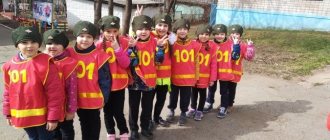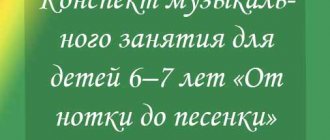Publications about the preparation and conduct of classes on fire safety. We strengthen children's knowledge about the causes of fires, safety rules at home and on the street. We form ideas about the benefits and harms of fire. We teach children to find the right way out of dangerous situations. We systematize their knowledge about what burns and what doesn’t burn. We make children want to be careful with fire always and everywhere. We cultivate responsibility for ourselves and for the lives of our loved ones. See what ways your colleagues have found to present material on fire safety in an entertaining way.
Introduction
Fire safety is one of the components of ensuring the national security of the country. A high level of fire safety is an integral component of the high level of socio-economic development of the Russian Federation. Fires cause significant material damage in all sectors of the national economy, leading to injuries and deaths.
In the Russian Federation, more than 130 thousand fires are recorded annually, as a result of which more than 8 thousand people die, the total losses amount to more than 100 billion rubles. The main causes and objects of fires are presented in the figure below.
The most important and obvious fire safety problem to be resolved, along with increasing the efficiency of the actions of fire departments of various types, is also increasing the effectiveness of preventive fire prevention measures and measures taken by citizens and owners to protect property from fire. Correct and timely work in this direction should have an important socio-economic effect in the form of voluntary and comprehensive compliance with fire safety requirements both personally by citizens and by enterprises, institutions and organizations within the framework of official or public activities.
Achieving this global goal is possible only if a high level of training is provided to the country's population in fire safety measures , which, in accordance with Article 1 of the Federal Law of December 21, 1994 No. 69-FZ “On Fire Safety” [1] refers to actions to ensure fire safety, including compliance with fire safety requirements. At the same time, fire safety requirements are special conditions of a social and (or) technical nature established in order to ensure fire safety by the legislation of the Russian Federation, regulatory documents or an authorized state body [1].
A special role in this process is given to managers and persons responsible for ensuring fire safety of organizations, who not only formulate the organization’s policy in the field of fire safety, develop and implement fire safety measures for a specific enterprise, but also have the right to independently train the rest of the employees of this enterprise in measures fire safety as part of fire safety instructions.
This course is intended for managers and persons responsible for ensuring fire safety in institutions (offices).
Violation of fire safety requirements: types, prevention of non-compliance with fire safety rules
In the course of their work activities, enterprise employees, out of ignorance or intentionally, violate federal and regional legislation relating to fire safety at industrial enterprises.
Because of this, fires occur, material damage is caused to organizations, accidents occur, harm is caused to human health, and some even die.
The existing legislation of the Russian Federation quite strictly controls the implementation of requirements and compliance with norms and rules in the field of industrial safety.
If workers or the employer violate the rules, various sanctions are imposed on the enterprise or other administrative measures are taken.
What types of fire safety violations occur in enterprises?
At the legislative level, regardless of the direction of the enterprise’s work activity and its specifics, the following types of gross violations of fire safety are distinguished :
- Storage and accounting of PPE (personal protective equipment) in case of fire . The employee responsible for fire safety at the facility is responsible for recording and storing these funds. Due to destruction in a fire, improper storage or loss of personal protective equipment and recording of a violation during a state or internal inspection, the responsible person is punished with disciplinary and material sanctions.
- Publication and placement of evacuation safety signs at the site . If signs are missing or incorrectly placed, government agencies impose large monetary fines. A special order is also issued to eliminate this discrepancy.
- Conducting training and control activities on industrial safety . These violations can be identified during the organization of internal events by the enterprise employees who are responsible for fire safety. This violation will subject the responsible persons to disciplinary action.
- Handling of flammable process substances . Because of this violation, abnormal and emergency situations often arise that cause material harm to production, health and human life. When such violations are recorded, those responsible are brought to all types of liability: administrative, disciplinary, civil and even criminal. The latter occurs due to severe and moderate harm to a person’s health or if due to this violation he died.
- Violation of fire safety regulations . This regime is regulated by federal law. All rules and regulations apply equally to both ordinary employees of the enterprise and management. Violation results in civil or administrative liability.
- Loss or damage to property that is necessary for the initial extinguishing of a fire . The person responsible for industrial safety is also responsible for compliance with this rule. Loss or damage can be detected during fire control measures carried out by enterprise managers or inspection authorities. The punishment is administrative liability.
- Failure to comply with rules and regulations during emergencies (emergency situations) . An emergency includes fire or fire. Violations include non-use of PST (primary extinguishing agents), malfunctions of sensors, systems and means that are responsible for monitoring the technical condition of the facility, lack of signaling equipment and information support systems. For this violation, those responsible will be subject to serious sanctions.
The listed violations may be due to the fault of both the management of the enterprise and the employees of the organization.
Prevention of non-compliance with rules
In order to prevent violations in the fire safety plan, labor safety engineers constantly carry out fire prevention actions among managers, responsible and working personnel of the enterprise.
Prevention includes the constant implementation of fire safety briefings, training and timely certification of employees, and regular fire drills.
The presence and condition of PPE, as well as systems responsible for alarms and fire extinguishing, are very strictly controlled. In addition, supervisory agencies monitor the presence of smoke detectors and other items that allow monitoring the fire situation at the facility.
The events we have listed are a whole range of work that must be comprehensive and permanent.
Technical measures to prevent PB
Technical fire safety prevention measures are a set of measures aimed at creating an effective system that prevents possible fires. This effective complex also guarantees prompt fire extinguishing and safe evacuation of people.
These measures include the following factors:
- Use of automatic fire alarms, which must be connected to duty stations.
- The use of household and industrial sensors that monitor temperature increases at the facility.
- Using object smoke sensors.
- Installation of automatic fire extinguishing systems.
- Use of fire shields, means for primary fire extinguishing and the required amount of personal protective equipment at the enterprise.
Main causes of fires
To successfully carry out fire prevention in enterprises, it is important to know the main causes of fires. Based on statistical data, we can conclude that the main causes of fires in production are:
— careless handling of fire;
— unsatisfactory condition of electrical devices and violation of the rules for their installation and operation;
— violation of technological process regimes;
— malfunction of heating devices and violation of the rules of their operation;
— failure to comply with the requirements of regulatory documents on fire safety issues.
Very often, industrial fires occur due to careless handling of fire. This usually means smoking in prohibited places and performing so-called hot work. Hot work is considered to be production operations involving the use of open fire, sparking and heating of parts, equipment, structures to temperatures capable of causing ignition of flammable substances and materials, vapors of flammable liquids. Hot work includes: gas and electric welding, gasoline and gas cutting, soldering work, cooking bitumen and resin, mechanical processing of metal with the formation of sparks.
Places for hot work can be permanent or temporary. Permanent places are determined by order of the head of the enterprise, and temporary places - by written permission of the head of the department. In accordance with fire safety requirements, there should be no flammable materials at the hot work sites within a radius of at least 5 m. It must be borne in mind that gas welding uses substances (acetylene, methane, oxygen) that increase the risk of fire and explosion.
Performers of work (electric and gas welders, soldering irons, resin cookers, etc.) must be instructed about fire safety measures by the persons responsible for this.
Before carrying out temporary fire work, fire safety measures are developed, the fire department is notified, persons responsible for ensuring fire safety are appointed, and after that a signed permit for the work is issued. This permission is given for one shift. After finishing hot work, the welder is obliged to inspect the work site and pour water on the combustible structures. The hot work site must be checked repeatedly within 2 hours after completion of work. Before welding a container in which liquid fuel or flammable gases were stored, it should be cleaned, washed with hot water and caustic soda, steamed, dried, ventilated, and an air analysis done. When welding, hatches and caps of the container must be open.
Responsibility for fire safety measures during welding and other hot work rests with the managers of sections, workshops, and enterprises.
According to statistics, fires that occur as a result of the unsatisfactory condition of electrical devices and violation of the rules for their installation and operation account for more than 25% of all cases, and depending on the causes, they are distributed as follows: about 45% occur due to short circuits, 35% - from electric heating devices, 13% - from overload of electric heaters and networks, 5% - from high transient resistances. Short circuits occur due to improper installation or operation of electrical installations, aging or damaged insulation. The short circuit current depends on the power of the current source, the distance from the current source to the fault location and the type of fault. Short circuits cause genuine heating of conductive parts, which can result in ignition of the insulation of conductors and combustible building structures. Overloads in electrical networks occur when additional consumers are connected to the network or when the voltage in the network decreases. Due to a significant increase in current consumption, excessive heating of the conductors occurs, which can cause fires.
An increase in local transient resistance occurs due to oxidation or insufficiently tight connection of the contacts of electrical machines. The resulting spark may start a fire. To prevent fire from high transition resistances, copper wires and cables are connected by twisting the cores and then soldering them. Aluminum cables are connected with sleeves.
The choice of electrical wiring diagrams, materials used, cross-sectional area of conductors and cables, type of insulation depends on the degree of fire hazard of the environment, operating mode of electrical installations and possible overloads: The cross-sectional area of conductors is selected according to the norms of permissible current loads and voltage drop in the network. Maximum current loads are given in special tables, taking into account the possible heating of conductors to a temperature of no more than 55 °C.
Fire prevention tasks
To ensure fire safety of enterprises during their design, construction and operation, fire prevention measures must be planned and implemented, which can be divided into groups:
- Measures aimed at preventing fire (eliminating direct or indirect causes of its occurrence):
— selection of technological processes, materials, equipment, modes of conducting processes and operating equipment, taking into account fire hazards, including the use of non-flammable and low-flammable materials and substances instead of fire hazardous ones;
— appropriate selection and installation of heating and ventilation systems, use of electrical equipment and lamps corresponding to the fire and explosion hazard class of the premises, group and category of explosive mixture;
— elimination of conditions for spontaneous combustion of substances and materials;
— application of measures to combat static electricity discharges and other types of sparking;
— establishing the maximum permissible heating temperature of equipment surfaces, flammable substances, materials, structures.
- Measures aimed at limiting the size and spread of a fire beyond its source:
— appropriate placement of production, buildings and structures on the territory of the facility;
— appropriate placement and layout of production workshops and areas, selection of building structures with the required fire resistance limits, taking into account the fire and explosion hazard of production processes;
— limiting the amount of flammable substances simultaneously present in the room;
— isolation of a flammable environment (sealing of equipment and containers with flammable substances), placement of fire-hazardous processes and equipment in isolated rooms;
- establishment of permissible areas of production compartments and sections, installation of fire barriers - walls, zones, protective strips, fire-resistant floors, doors, partitions, use of fire-retarding devices, non-combustible and low-combustible structural elements of buildings and structures, impregnation of combustible structures with fire retardants to increase their fire resistance;
— installation of automatic fire alarms and use of fire extinguishing means, including automatic ones.
The main tasks of fire prevention:
- organizing and monitoring the fire safety condition of the facility;
- development and implementation of fire safety measures;
- monitoring compliance with fire safety requirements;
- development of proposals for fire prevention;
- training in fire safety measures and actions in case of fire;
- conducting fire prevention propaganda; monitoring the condition and performance of fire protection systems and means.
Preventive measures
The priority fire prevention measures that are carried out at the facility are:
- The use of non-flammable detergents in places where parts or finished products are degreased and cleaned.
- Collection of information on fire hazard parameters of various substances and materials used in the technological process.
- Involvement of automatic fire safety systems.
- Regular testing of the functionality of fire automatic systems.
- Insulation of fire hazardous technological equipment. If necessary, it can be taken out to open areas of the territory.
- The use of fire barriers and quick-acting valves that will prevent the rapid spread of fire throughout the premises and communications.
- A ban on the use of flammable materials during repair work on evacuation routes.
- Use of special smoke protection and other systems in the most fire-hazardous areas.
The effectiveness of fighting fires is ensured only at those enterprises where organizational and propaganda work is well done. Also, exemplary enterprises have and operate a VPD (voluntary fire brigade) and a PTK (fire-technical commission).
According to statistical information, in enterprises more than half of all fires occur due to human negligence or gross violation of existing fire safety rules by employees. The most common causes of fire today include:
- Smoking in places that are not intended for this.
- Electrical household appliances that are not turned off.
- The use of torches or blowtorches to heat parts, pipes and other structures.
To completely eliminate the reasons listed above, it is necessary to introduce the most stringent fire safety regime, and employees are constantly taught the basic rules of fire safety.
Fire regulations in the Russian Federation
The fire safety regime within the Russian Federation is regulated by law. For this purpose, Federal laws, Decrees of the Government and the Ministry of Emergency Situations of the Russian Federation, Fire Safety Standards have been developed and approved, which in many provisions contradict each other or do not contain complete information on a particular issue. Since April 25, 2012, for organizations of the Russian Federation of all forms of ownership and types of activity, the Fire Safety Rules, approved by Decree of the Government of the Russian Federation No. 390, have been in effect.
The introduction of a fire safety regime at enterprises is necessary in order not only to train people in the correct actions in case of fire, but also how to safely carry out their work functions within the territory of the organization, thereby avoiding fires and their consequences.
Definition, purpose
In order to avoid fires in the territories of organizations, settlements, social and cultural objects and when performing fire-hazardous work, every citizen is obliged to know and apply fire safety rules in practice. Resolution No. 390 defines what a fire safety regime is.
Actions of citizens, workers, heads of commercial and social organizations, which are aimed at eliminating all possible causes of fire - these are the rules of the fire safety regime in the Russian Federation. The same document contains guidance in case failure to comply with any requirement leads to a fire.
Introduction of a special fire regime
A special fire regime is a period when, throughout the entire territory of a constituent entity of the Russian Federation, careful compliance with norms and rules aimed at preventing fires is required. This period is introduced by local governments based on fire statistics for previous years, meteorological conditions and the situation in a certain area of a constituent entity of the Russian Federation, for example, the occurrence of large forest fires.
During the fire danger period, a fire safety regime is introduced
The rules of the fire regime in the Russian Federation require, before the introduction of a special situation, the organization of a commission for the prevention and liquidation of emergencies in the designated territory of a constituent entity of the Russian Federation, which will make a decision on this issue.
The fire regime is a special period that is introduced in the presence of the following conditions in a separately designated area:
increasing statistics on the occurrence of fires in the residential sector;
there was a fire or several fires that resulted in significant public outcry;
squally winds with a speed of 30 m/s or more, as well as air temperatures above 30 degrees Celsius throughout the calendar week;
forest fires lasting 2 or more days.
As soon as one of the above conditions arises, the commission issues a decision - an order on the fire safety regime, which contains the following data:
reasons for introducing a special fire regime;
recommendations for maintaining the required level of fire safety throughout the dangerous period;
a set of measures with which you can quickly restore the territory and eliminate the causes that may contribute to the occurrence of fires;
standards for the work of the fire department for this period;
algorithm for monitoring the fulfillment of order requirements.
The average duration of the fire regime is from 14 to 90 days, it depends on the situation in the locality, as well as on the level of implementation of fire safety measures. If the commission decides to lift the regime, then an order is issued to cancel it.
Compliance with increased safety requirements during fire danger also applies to organizations of all forms of ownership, especially those serving the social sphere. For this purpose, each organization appoints a person responsible for fire safety. At the same time, an order is issued to organize a fire safety regime in the organization. The document specifies the requirements that must be observed in order to avoid fires on the territory of a particular legal entity and in its buildings, structures, and premises.
Local governments are planning to attract additional forces and resources to eliminate fires and prevent their occurrence, and to finance these activities:
payment for modernized fire fighting equipment, machines, devices for fire extinguishing needs;
remuneration for firefighters who work in conditions of increased risk to their lives.
The technical part of fire protection measures in hazardous areas consists of the following elements:
Informing the population through telecommunications.
Bringing existing water-carrying equipment into readiness mode.
Patrolling of the populated area by employees of the voluntary fire brigade for fires.
Installation of water containers near residential buildings.
Explanatory work with citizens by visiting residential apartments and houses.
Prohibition on carrying out fire-hazardous work, firing furnaces and boiler rooms.
Fencing the forest area from unauthorized persons.
Removing dried vegetation.
Construction of fire protection strips along forest areas.
Hiring public transport in case of emergency evacuation of residents and material assets.
Organization of round-the-clock duty of voluntary squads in production organizations, providing them with primary fire extinguishing means.
Topic 6. Practical exercises
Question No. 1. Organization of personnel evacuation.
Practical testing of evacuation plans is an important part of the professional training of enterprise employees (Fig. 1).
Rice. 1. Scheme of working out the evacuation plan.
During training, workers develop the skills to quickly find the right solutions in fire conditions, collectively carry out evacuation and rescue, work to extinguish a fire in its initial stage, and correctly use primary fire extinguishing agents.
At each facility, as part of the annual work schedule with personnel, a fire training schedule must be drawn up, approved by the head of the enterprise.
The schedule indicates: the month of the training, the type of training, the training shift or structural unit.
The annual schedule is developed jointly with the heads of structural divisions. The effectiveness of fire drills depends on the correctness of their preparation and organization, on the quality of the analytical study of the actions of workers during the training and the correctness of the decisions made based on the results of a critical analysis (discussion) of the training after its completion.
The effectiveness of fire-fighting training also largely depends on the results achieved during briefings conducted as part of the general fire-fighting training program for subordinates. Training during training is more successful if briefings were carried out shortly before the start of training; therefore, before the start of training, all participants should gather in the hall, where the training leader, using an evacuation plan, explains the task of each participant (Fig. 2).
Rice. 2. Actions of the enterprise manager in case of fire.
Fire training is divided into: site-based, joint with Federal Border Guard units and individual.
On-site fire training should be considered a training the topic of which is a violation of the operating mode of the facility as a whole due to a fire, and the personnel of the entire facility are involved in it. The head of the site fire drill is responsible for ensuring fire safety.
A training session of a structural unit should be considered a training session, the topic of which is a violation of the operating regime of one structural unit and in which the participation of personnel of only this unit is required.
Employees of the enterprise and the Federal Border Service department participate in joint training. Joint training allows you to work out the interaction and mutual understanding of the facility personnel and the Federal Border Guard units.
During the period of joint training, by order of the facility manager, consultants are allocated from among engineering and technical workers who are required to ensure that the orders and actions of the training manager and the fire extinguishing manager comply with the requirements of the safety regulations in force at the facility.
Evacuation training is assigned by order of the facility manager to prepare the training, which reflects the purpose, date and time, training leader, and chief of the training staff.
The head of the training staff develops a training plan, which reflects the topic of the training, its goals, the composition of participants and the calendar plan for preparation and conduct. The calendar plan reflects the stages of preparation and conduct of the training, tasks for the headquarters, personnel, intermediaries and participants, indicating the venues, times and responsible persons. The order (stages) of training can be determined both by the calendar plan and by a separate document approved by the training director.
The effectiveness of the training largely depends on the actions of the intermediaries and the personnel themselves. Intermediaries are appointed from among the engineering personnel of the facility, and in case of joint training, additionally from the personnel of the FPS unit. The number of intermediaries is determined by the training leader.
When training mediators, the training leader should:
- familiarize them with the tactical concept of the training and possible options for solving it;
- organize with them a study of the facility where the training will be carried out, distribute them among work areas;
- introduce responsibilities as mediators;
- give instructions on the procedure for using simulation means in a simulated fire;
- pay attention to the need to observe safety precautions during training.
The intermediary is obliged:
- get acquainted with the tactical plan and the expected decision on the created situation;
- in accordance with the procedure prescribed by the training leader, simulate the situation of a simulated fire, announce inductions to personnel on time and in the appropriate place;
- if necessary, immediately take measures to prevent erroneous actions of any training participant that could lead to an accident, breakdown, equipment damage or disruption of the technological process;
- keep the necessary records of the actions of personnel during training and the implementation of introductory instructions.
Intermediaries should not allow such clarifications that could serve to reveal the tactical plan of the training leader. If there are means of simulating the situation of a simulated fire, the intermediaries may not give introductions, but ask the trainees what kind of situation they encountered and what decision they made.
Any training participant can check with the intermediary for information about the situation at the site of the simulated fire.
When training personnel, the training director must:
- Provide information about the space-planning solutions of the facility, the state of fire protection systems, including warning and management of evacuation of people in case of fire;
- Convey the training intent;
- Explain the procedure for action in the event of a fire, as well as the stages of fire development, the procedure for independently extinguishing a fire, providing first aid to victims, etc.
All categories of participants during fire training must have the following distinctive signs:
- intermediaries - a distinctive bandage on the right sleeve;
- fire extinguishing leader - a red distinctive bandage;
- training staff - a yellow bandage on the right sleeve.
The situation of a simulated fire during fire training is simulated by the following means:
- the source of the fire is marked with red flags;
- smoke zone - blue flags;
- zone of toxic gases, radioactivity, release of harmful vapors - yellow flags.
The simulation of a fire during training must be visual and such that intermediaries have the opportunity to change it in a certain area in accordance with the tactical plan of the training leader.
As a means of simulating a fire, it is allowed to use lanterns and other means that help create the necessary environment.
It is prohibited to use means for imitation that can cause a fire or cause damage to premises and equipment.
Question No. 2. Working with a fire extinguisher.
The success of using fire extinguishers depends not only on their working condition, but also on how familiar workers and medical personnel are with the principle and features of their use. You should study the instructions for use, inscriptions and pictograms on the bodies of fire extinguishers, showing the procedure for putting them into action, not in the event of a fire, but in the calm conditions of regular fire safety briefings. It is necessary to provide each employee with the opportunity not only to hold a fire extinguisher in their hands (assess its weight and their capabilities), but also to try to remove it from the hanging brackets (if it is not located in a special cabinet, but on the wall or on the floor using means of securing it from a possible fall in case of accidental exposure). Training with the practical use of fire extinguishers is considered ideal.
The most common types of fire extinguishers today are: dry powder fire extinguishers (PD), carbon dioxide fire extinguishers (COF) and air-foam fire extinguishers (AFF). The operating principle of these types of fire extinguishers is the same (Fig. 3):
1) it is necessary to break the seal and remove the blocking clip (safety pin);
2) then you should hit the fire extinguisher trigger button with your hand or operate the trigger lever located in the fire extinguisher head;
3) direct the fire extinguishing agent through the barrel, nozzle, socket or hose to the source of combustion.
Rice. 3. The procedure for preparing for work and using a fire extinguisher.
The peculiarity of using powder-type fire extinguishers is that in a confined space, passage through the emission zone of fine powder becomes impossible: the powder clogs the eyes and respiratory tract. Therefore, powder fire extinguishers should be used at a location between the fire source and the emergency exit. It is allowed to extinguish equipment under voltage up to 1000 V with powder fire extinguishers.
The peculiarity of using carbon dioxide type fire extinguishers is that carbon dioxide does not cause damage to the extinguishing object and has good dielectric properties (it is possible to extinguish electrical equipment under voltage up to 1000 V). However, the use of carbon dioxide also has disadvantages: cooling of metal parts and the fire extinguisher pipe reaches minus 70 ° C; in a confined space, there is a noticeable decrease in oxygen content and an increase in the proportion of carbon dioxide, which can cause suffocation and loss of consciousness.
A peculiarity of the use of air-foam fire extinguishers is that they are strictly prohibited from extinguishing electrical equipment under voltage without first de-energizing it (air-mechanical foam contains water and does not have dielectric properties).
The peculiarity of using sand to extinguish spilled flammable liquids (kerosene, gasoline, oils, resins, adhesives, paints, etc.) is that the sand should not be poured into the combustion area (otherwise the burning liquid will splash and spread), but mainly along the the outer edge of the burning zone, trying to surround the burning area with sand. Then, using a shovel, you need to cover the burning surface with a layer of sand, which will absorb the liquid and put out the fire.
Blankets for isolating the source of fire are effectively used to isolate the source of combustion from air access, but can be safely used only with a small source of combustion - on an area of no more than 50% of the area of the sheet used.
Question No. 3. Using a fire hydrant.
Each fire hydrant is equipped with a fire hose and a barrel of the same diameter and the same type of connection. If booster pumps are used, a remote control button is installed in the fire cabinet next to the fire hydrant for starting. The fire hose should be folded into an accordion or double roll. The hose must be kept dry and at least once a year it must be unrolled and turned over to a new edge (clause 50 of the Fire Safety Rules in the Russian Federation [2]), about which a corresponding entry is made in the operation log of fire protection systems.
At least 2 times a year (in spring and autumn), it is necessary to carry out inspections of the internal fire-fighting water supply in terms of water loss (clause 48 of the Rules of the fire safety regime in the Russian Federation [2]), with information on the results of the checks being entered into the log of the operation of fire protection systems.
In case of fire, using a fire hydrant usually requires two people. The first person breaks the seal and opens the fire cabinet, the second person unwinds the fire hose with the barrel in the direction of the fire. The first one opens the tap and, if necessary, starts the booster pumps, the second one works with the barrel to extinguish the fire (Fig. 4).
Rice. 4. Procedure for using an internal fire hydrant.
Question No. 4. First aid for thermal burns
The degree of skin damage due to thermal exposure depends on the following factors: temperature of influence (the higher the temperature, the stronger the damage); duration of exposure to the skin (the longer the contact time, the more severe the degree of burn); condition of the skin and health of the victim. Superficial skin lesions on an area of more than 15–25% and deep ones of more than 10% lead to the occurrence of burn disease, which occurs when massive tissue destruction occurs with the release of a large amount of biologically active substances.
Degrees of burns:
1st degree
Redness of the burned area, swelling and pain. The skin at the site of the lesion is bright pink, sensitive to touch and slightly protrudes above the healthy area of skin.
2nd degree
At the site of the lesion, hyperemia, swelling, and burning pain are noted. Due to the detachment of the epidermis, small and relaxed blisters appear on the surface of the skin, filled with light yellow, transparent liquid. If the blisters break, a reddish erosion is observed in their place.
3-A degree
Deeper skin damage occurs. Tissue necrosis and edema are noted, spreading throughout the entire thickness of the skin. At degree 3-A, a dry light brown or soft white-gray burn crust forms. Tactile pain sensitivity of the skin is preserved or reduced. Blisters with a dense wall, filled with a thick, yellow, jelly-like liquid, form on the affected surface.
3-B degree
Necrosis affects the entire thickness of the skin with partial involvement of subcutaneous fat. The formation of blisters filled with dark liquid with a reddish tint (admixture of blood) is observed. The bubbles burst quickly. The resulting burn crust is dry or wet, yellow, gray or dark brown. There is a sharp decrease or absence of pain.
4th degree
Not only all layers of the skin are affected, but also muscles, fascia and tendons down to the bones. A dark brown or black burn crust forms on the affected surface, through which the venous network is visible. Due to the destruction of nerve endings, there is no pain.
First aid:
Stop exposure to the damaging factor. The victim must be removed from the fire, extinguish burning clothing, stop contact with hot objects, liquids, steam, etc. Provide an ambulance call.
For 1-2 degree burns, cool the burn site with cool running water at a temperature of 10-15 degrees for 10-15 minutes to prevent damage to healthy tissue in the burn area. The action of cold water leads to vasospasm and a decrease in the sensitivity of nerve endings, and has an analgesic effect.
To prevent microbial infection, apply an aseptic bandage, loosely covering the affected area. Before applying an aseptic dressing, you must carefully cut off the clothing from the burned areas. Do not try to clean the burned areas (remove pieces of clothing stuck to the skin, resin, etc.), or open blisters. It is not recommended to lubricate burned areas with vegetable and animal fats. Dry and clean scarves, towels, and sheets can be used as an aseptic dressing.
Keep the victim calm and give plenty of fluids.
Bibliography:
- Federal Law of December 21, 1994 No. 69-F3 “On Fire Safety”.
- Decree of the Government of the Russian Federation of September 16, 2022 No. 1479 “On approval of the Fire Regulations in the Russian Federation.”
- Order of the Ministry of Emergency Situations of Russia dated December 12, 2007 No. 645 (as amended on June 22, 2010) “On approval of fire safety standards “Training in fire safety measures for employees of organizations.”
- Order of the Ministry of Health and Social Development of the Russian Federation dated May 4, 2012 No. 477n “On approval of the list of conditions for which first aid is provided and the list of measures to provide first aid.”
- Methodological recommendations “Organization of training for the evacuation of personnel of enterprises and institutions in case of fire” (approved by the Ministry of Emergency Situations of the Russian Federation 09/04/2007 N 1-4-60-10-19).
- Methodological recommendations for public authorities of the constituent entities of the Russian Federation on training the population in fire safety measures. – M.: VNIIPO, 2012. – 187 p.
- Short course of fire-technical minimum: Textbook. allowance / Sobur S.V. – 10th ed., revised. – M.: PozhKniga, 2022. – 288 p.
Rights, duties, responsibilities for ensuring fire safety.
Rights and obligations of organizations in the field of fire safety (Article 37 No. 69-FZ):
The heads of the organization have the right:
create, reorganize and liquidate in the prescribed manner fire departments, which they maintain at their own expense;
make proposals to state authorities and local governments to ensure fire safety;
carry out work to establish the causes and circumstances of fires that occurred at enterprises;
establish measures of social and economic incentives to ensure fire safety;
receive information on fire safety issues, including in the prescribed manner from management bodies and fire departments.
The leaders of the organization are obliged:
comply with fire safety requirements, as well as comply with orders, regulations and other legal requirements of fire officials;
develop and implement measures to ensure fire safety;
conduct fire prevention propaganda, as well as train their employees in fire safety measures;
include fire safety issues in the collective agreement (agreement);
maintain fire protection systems and means, including primary fire extinguishing means, in good condition, and prevent their use for other purposes;
provide assistance to fire protection in extinguishing fires, establishing the causes and conditions of their occurrence and development, as well as in identifying persons guilty of violating fire safety requirements and causing fires;
provide, in accordance with the established procedure, the necessary forces and means when extinguishing fires on the territories of enterprises;
provide access to fire officials when performing their official duties on the territory, buildings, structures and other facilities of enterprises;
provide, at the request of state fire supervision officials, information and documents on the state of fire safety at enterprises, including the fire hazard of the products they produce, as well as fires that occurred on their territories and their consequences;
immediately report to the fire department about fires, malfunctions of existing systems and fire protection equipment, changes in the condition of roads and passages;
promote the activities of volunteer firefighters;
ensure the creation and maintenance of fire protection units at facilities based on the requirements established by Article 97 of Federal Law No. 123-FZ of July 22, 2008 “Technical Regulations on Fire Safety Requirements.”
Fire training at the enterprise
Fire safety of an enterprise is a set of measures that includes technical means, organizational measures, inspections, theoretical briefings and practical lessons for employees. Only by ensuring the necessary actions in all directions can a favorable outcome from an emergency be guaranteed.
A special place in the complex of measures is occupied by fire training at the enterprise, regulatory documents that regulate training: methodological recommendations and orders of the Ministry of Emergency Situations, as well as internal documents of the organization.
Their goal is to train personnel in the rules of behavior in case of fire: calling the emergency services team, extinguishing fires, removing people from the building, and much more.
Emergency evacuation drills
Sample fire drill schedule
The consistency of people's actions, even in ordinary situations, is formed in practice. In an extreme situation, only practiced maneuvers can prevent the group from turning into a disorganized crowd. Therefore, a fire training schedule is drawn up for the year. There is no special form for this document; the requirements are established only by office work standards. Classes can be conducted in three formats:
- briefings at various levels: from primary to targeted;
- classes on PTM (fire-technical minimum);
- training practice.
All types of exercises must be included in the document.
You can see a sample fire drill plan in the figure.
Sample exercise schedule
Fire drill goals
The purpose of fire safety training in an organization is to teach competent and prompt actions in case of fire: extinguishing the source or preventing the spread of fire, reporting to the Ministry of Emergency Situations and an organized exit from the building. After receiving the information, employees take exams to master the topic. If the majority of the team does not pass the test, it is repeated at the following intervals:
- directly at workplaces – after 10 days;
- at a production facility – 14 days;
- combined training with EMERCOM teams – 30 days.
If some employees were unable to pass the exam, they are assigned individual lessons.
Fire extinguishing equipment training
The main objectives of fire safety training at an enterprise
The fire safety training instructor has the following tasks:
- training people to take correct and timely actions when receiving an alarm or detecting a fire: from calling the Ministry of Emergency Situations to evacuating colleagues;
- knowledge of the rules for localizing fires or preventing the spread of flames;
- availability of skills in handling and using personal protective equipment and technical fire extinguishing equipment;
- ability to interact with fire brigades of the Ministry of Emergency Situations;
- availability of knowledge on PPB.
LITERATURE
- Federal Law of December 21, 1994 No. 69-FZ “On Fire Safety”;
- Federal Law of July 22, 2008 No. 123-FZ “Technical Regulations on Fire Safety Requirements”;
- Federal Law of December 26, 2008 No. 294-FZ “On the protection of the rights of legal entities and individual entrepreneurs in the exercise of state control (supervision) and municipal control”;
- Decree of the Government of the Russian Federation dated April 25, 2012 No. 390 “On the fire safety regime” (together with the “Fire safety regulations in the Russian Federation”).








